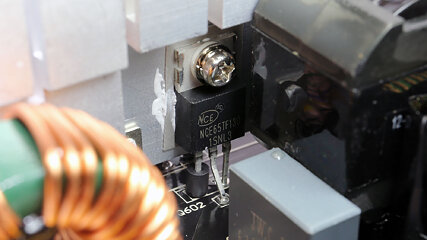 11
11
Cougar Polar 1200 W Review - Great Performance!
Voltage Regulation Stability & Ripple »Component Analysis
Before reading this page, we strongly suggest looking at this article, which will help you better understand the insides of a PSU.| Cougar Polar 1200 Parts Description | |
|---|---|
| General Data | |
| Manufacturer (OEM) | Xin Hui Yuan Tech (XHY) |
| PCB Type | Double-sided |
| Primary Side | |
| Transient Filter | 4x Y caps, 2x X caps, 2x CM chokes, 1x MOV |
| Bridge Rectifier(s) | 2x MCC GBU15KL (800 V, 15 A @ 100°C) |
| Inrush Current Protection | NTC thermistor (MF72-5D15) (5 ohm) & relay |
| APFC MOSFETs | 2x 65R078W |
| APFC Boost Diode | 1x G3S06510A |
| Bulk Cap(s) | 2x Nippon Chemi-Con (450 V, 560 uF each or 1120 uF combined, 2,000 h @ 105°C, KMW) |
| Main Switchers | 4x NCE Power NCE65TF130 (650 V, 18 A @ 100°C, Rds (on): 0.13 ohm) |
| APFC Controller | Champion CM6500UNX |
| Switching Controller | Champion CM6901T6X |
| Topology | Primary Side: APFC, full-Bridge & LLC converter Secondary Side: synchronous rectification & DC-DC converters |
| Secondary Side | |
| +12 V MOSFETs | 8x Infineon BSC010N04LS (40 V, 178 A @ 100°C, Rds (on): 1 mOhm) |
| +5 V & +3.3 V | DC-DC Converters: 6x Excelliance MOS EMB04N03H (30 V, 45 A @ 100°C, Rds (on): 4 mOhm) PWM Controller(s): uPI-Semi uP3861P |
| Filtering Capacitors | Electrolytic: 4x Nippon Chemi-Con (105°C, W) 14x Nippon Chemi-Con (4–10,000 h @ 105°C, KY) Polymer: 9x FPCAP 4x Elite 8x no information available |
| Supervisor IC | IN1S4241-SDG |
| Fan Model | DWPH EFF-14E12H (140 mm, 12 V, 0.30 A, hydraulic bearing fan) |
| 5VSB Circuit | |
| Rectifier(s) | 60R10S SBR |
| Standby PWM Controller | Excelliance MOS Corp EM8569C |
The platform looks nice. The heatsink leaning on the bridge rectifiers is not Cougar's fault. I did it to identify the bridge rectifier model numbers and forgot to straighten it out before I took the photos. Build quality is high, and the large PCB helps with airflow. The OEM used a full-bridge topology and an LLC resonant converter on the primary side. We meet a synchronous rectification scheme for +12 V and a pair of DC-DC converters for the minor rails on the secondary side.
The transient filter has all necessary components, including an MOV.
The NTC thermistor protects against large inrush currents and is supported by a bypass relay.
The two bridge rectifiers can handle up to 30 A combined.
The APFC converter uses two 65R078W FETs and a single G3S06510A boost diode. The bulk caps are by Chemi-Con, and their combined capacity is 1120 uF.
The APFC controller is a Champion CM6500UNX.
The four NCE Power primary switching FETs are installed in a full-bridge topology.
The resonant controller is a Champion CM6901T6X.
The main transformer is next to the parts for the LLC resonant controller.
Eight Infineon FETs regulate the +12 V rail. They are installed on the solder side of the PCB.
The electrolytic caps on the secondary side are by Nippon Chemi-Con, and most of them belong to the high-end KY line. Many polymer caps are also used for ripple-filtering purposes.
Two DC-DC converters generate the minor rails.
The standby PWM controller is an EM8569C IC, and one of the 5VSB rectifiers is a 60R10S SBR.
The supervisor controller is an IN1S4241-SDG.
Several polymer and electrolytic caps installed on the main PCB reduce ripple further.
Soldering quality is good!
We usually find a Hong Hua fan on mid and high-end units, but the OEM chose DWPH. According to specifications, the fan uses a hydraulic dynamic bearing, so I expect it to be good.
Apr 4th, 2025 05:22 EDT
change timezone
Latest GPU Drivers
New Forum Posts
- Show us your backside! (9)
- What's your latest tech purchase? (23468)
- Help me pick a UPS (54)
- Since all gpu's models perform the same, why review dozen of different models? (29)
- Why does a red screen appear when pressing F1 after updating the BIOS? (1)
- RX 9000 series GPU Owners Club (134)
- AIO - 120mm cpu cooler? (44)
- Is RX 9070 VRAM temperature regular value or hotspot? (315)
- DTS DCH Driver for Realtek HDA [DTS:X APO4 + DTS Interactive] (2125)
- The TPU UK Clubhouse (26039)
Popular Reviews
- DDR5 CUDIMM Explained & Benched - The New Memory Standard
- PowerColor Radeon RX 9070 Hellhound Review
- Sapphire Radeon RX 9070 XT Pulse Review
- Corsair RM750x Shift 750 W Review
- Pwnage Trinity CF Review
- Sapphire Radeon RX 9070 XT Nitro+ Review - Beating NVIDIA
- Upcoming Hardware Launches 2025 (Updated Apr 2025)
- SilverStone Lucid 04 Review
- Palit GeForce RTX 5070 GamingPro OC Review
- AMD Ryzen 7 9800X3D Review - The Best Gaming Processor
Controversial News Posts
- MSI Doesn't Plan Radeon RX 9000 Series GPUs, Skips AMD RDNA 4 Generation Entirely (146)
- Microsoft Introduces Copilot for Gaming (124)
- AMD Radeon RX 9070 XT Reportedly Outperforms RTX 5080 Through Undervolting (119)
- NVIDIA Reportedly Prepares GeForce RTX 5060 and RTX 5060 Ti Unveil Tomorrow (115)
- Over 200,000 Sold Radeon RX 9070 and RX 9070 XT GPUs? AMD Says No Number was Given (100)
- NVIDIA GeForce RTX 5050, RTX 5060, and RTX 5060 Ti Specifications Leak (96)
- Retailers Anticipate Increased Radeon RX 9070 Series Prices, After Initial Shipments of "MSRP" Models (90)
- Nintendo Switch 2 Launches June 5 at $449.99 with New Hardware and Games (90)







































